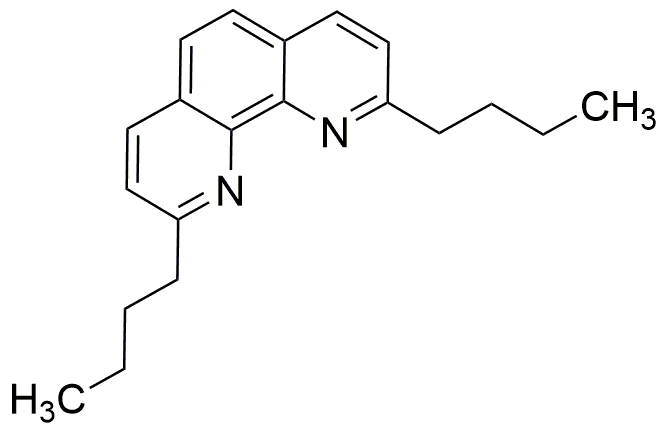2,9-Dibutyl-1,10-phenanthroline is widely utilized in research focused on:
- Coordination Chemistry: This compound serves as a ligand in coordination complexes, enhancing the stability and reactivity of metal ions in various chemical reactions.
- Analytical Chemistry: It is used in the development of sensors and probes for detecting metal ions, providing a reliable method for environmental monitoring and quality control in industries.
- Material Science: The compound is incorporated into polymer matrices to improve the properties of materials, such as increasing thermal stability and mechanical strength.
- Photochemistry: It plays a role in the design of light-harvesting systems and photonic devices, contributing to advancements in solar energy applications.
- Biomedical Research: Researchers utilize it in studies related to drug delivery systems and bioimaging, where its unique properties can enhance the efficacy of therapeutic agents.
General Information
Properties
Safety and Regulations
Applications
2,9-Dibutyl-1,10-phenanthroline is widely utilized in research focused on:
- Coordination Chemistry: This compound serves as a ligand in coordination complexes, enhancing the stability and reactivity of metal ions in various chemical reactions.
- Analytical Chemistry: It is used in the development of sensors and probes for detecting metal ions, providing a reliable method for environmental monitoring and quality control in industries.
- Material Science: The compound is incorporated into polymer matrices to improve the properties of materials, such as increasing thermal stability and mechanical strength.
- Photochemistry: It plays a role in the design of light-harvesting systems and photonic devices, contributing to advancements in solar energy applications.
- Biomedical Research: Researchers utilize it in studies related to drug delivery systems and bioimaging, where its unique properties can enhance the efficacy of therapeutic agents.
Documents
Safety Data Sheets (SDS)
The SDS provides comprehensive safety information on handling, storage, and disposal of the product.
Product Specification (PS)
The PS provides a comprehensive breakdown of the product’s properties, including chemical composition, physical state, purity, and storage requirements. It also details acceptable quality ranges and the product's intended applications.
Certificates of Analysis (COA)
Search for Certificates of Analysis (COA) by entering the products Lot Number. Lot and Batch Numbers can be found on a product’s label following the words ‘Lot’ or ‘Batch’.
*Catalog Number
*Lot Number
Certificates Of Origin (COO)
This COO confirms the country where the product was manufactured, and also details the materials and components used in it and whether it is derived from natural, synthetic, or other specific sources. This certificate may be required for customs, trade, and regulatory compliance.
*Catalog Number
*Lot Number
Safety Data Sheets (SDS)
The SDS provides comprehensive safety information on handling, storage, and disposal of the product.
DownloadProduct Specification (PS)
The PS provides a comprehensive breakdown of the product’s properties, including chemical composition, physical state, purity, and storage requirements. It also details acceptable quality ranges and the product's intended applications.
DownloadCertificates of Analysis (COA)
Search for Certificates of Analysis (COA) by entering the products Lot Number. Lot and Batch Numbers can be found on a product’s label following the words ‘Lot’ or ‘Batch’.
*Catalog Number
*Lot Number
Certificates Of Origin (COO)
This COO confirms the country where the product was manufactured, and also details the materials and components used in it and whether it is derived from natural, synthetic, or other specific sources. This certificate may be required for customs, trade, and regulatory compliance.


